Foundation Course: Personal and Professional Development Report
VerifiedAdded on 2020/05/04
|14
|3666
|33
Report
AI Summary
This report examines personal and professional development within a health and social care setting, focusing on a case study involving the Bluebell ward. It begins by exploring how personal values and cultural experiences influence individual contributions to the workplace, considering the impact of cultural preferences and differences on patient care. The report then delves into learning styles and the application of learning theories, assessing current skills and abilities, and constructing a holistic learning and development plan with short, medium, and long-term goals. The plan is designed to be reviewed regularly to monitor progress and align with the requirements of a health and social care practitioner. Finally, the report analyzes the nature of different professional relationships within the Bluebell ward, emphasizing the importance of effective communication and ethical considerations in providing quality care.
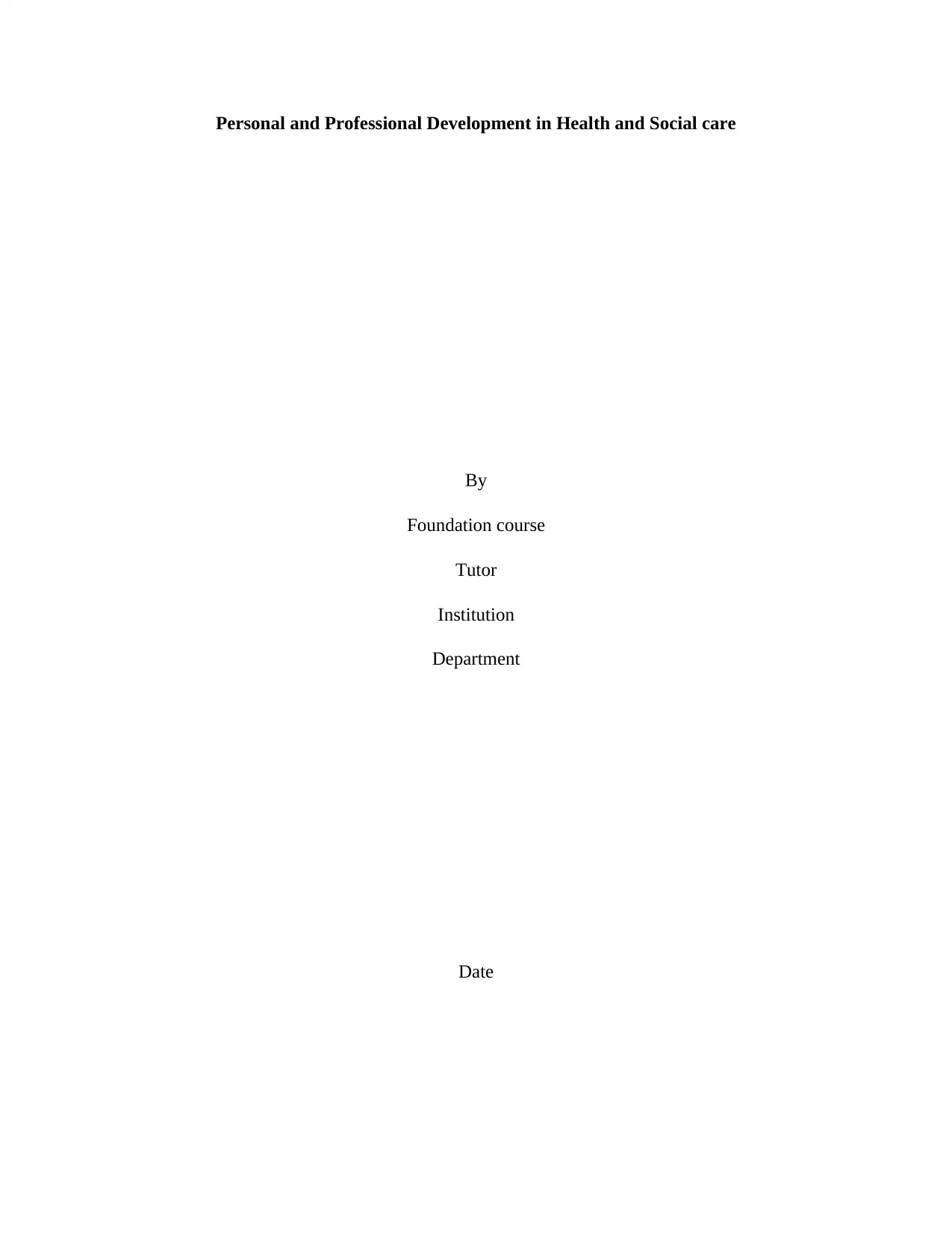
Personal and Professional Development in Health and Social care
By
Foundation course
Tutor
Institution
Department
Date
By
Foundation course
Tutor
Institution
Department
Date
Paraphrase This Document
Need a fresh take? Get an instant paraphrase of this document with our AI Paraphraser
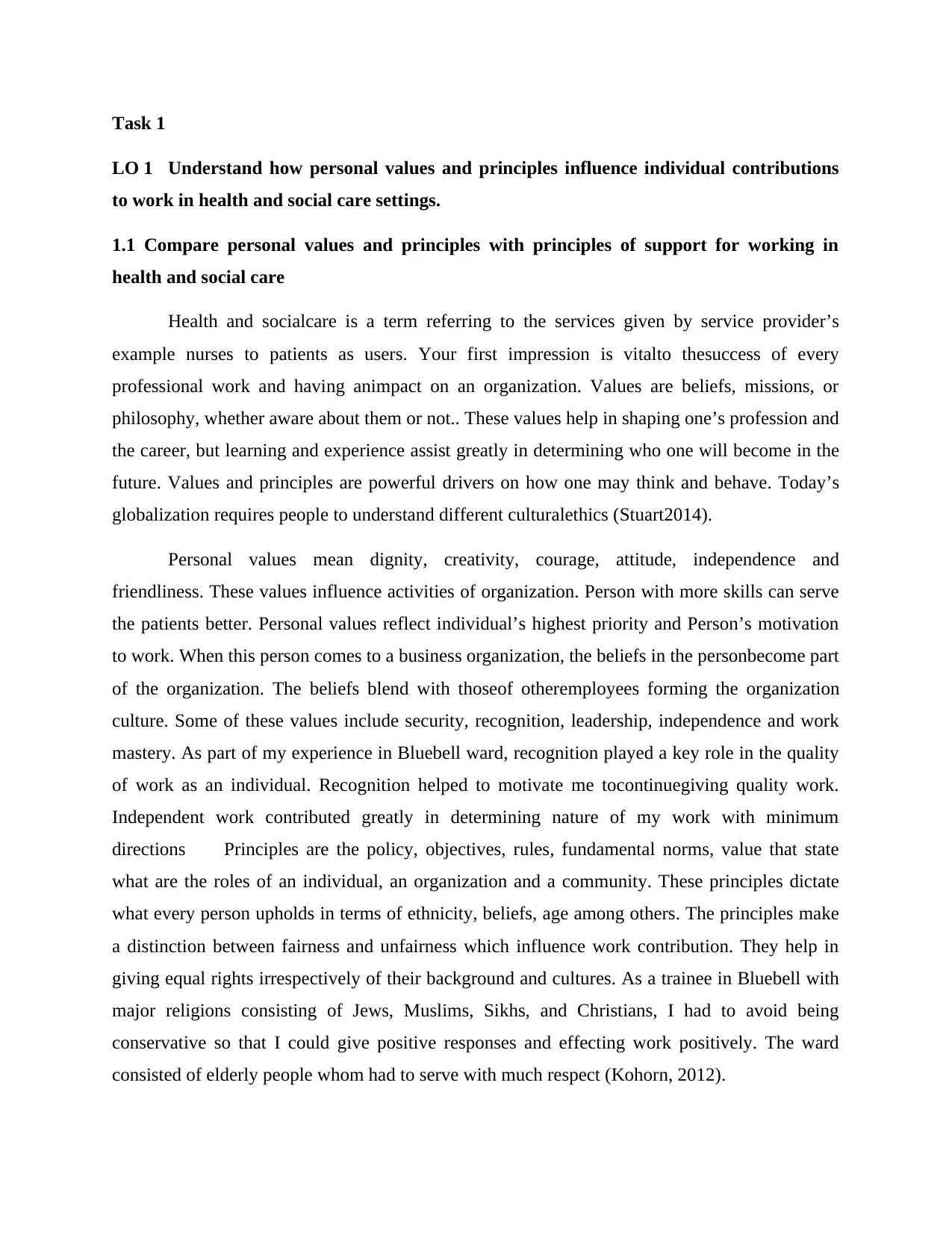
Task 1
LO 1 Understand how personal values and principles influence individual contributions
to work in health and social care settings.
1.1 Compare personal values and principles with principles of support for working in
health and social care
Health and socialcare is a term referring to the services given by service provider’s
example nurses to patients as users. Your first impression is vitalto thesuccess of every
professional work and having animpact on an organization. Values are beliefs, missions, or
philosophy, whether aware about them or not.. These values help in shaping one’s profession and
the career, but learning and experience assist greatly in determining who one will become in the
future. Values and principles are powerful drivers on how one may think and behave. Today’s
globalization requires people to understand different culturalethics (Stuart2014).
Personal values mean dignity, creativity, courage, attitude, independence and
friendliness. These values influence activities of organization. Person with more skills can serve
the patients better. Personal values reflect individual’s highest priority and Person’s motivation
to work. When this person comes to a business organization, the beliefs in the personbecome part
of the organization. The beliefs blend with thoseof otheremployees forming the organization
culture. Some of these values include security, recognition, leadership, independence and work
mastery. As part of my experience in Bluebell ward, recognition played a key role in the quality
of work as an individual. Recognition helped to motivate me tocontinuegiving quality work.
Independent work contributed greatly in determining nature of my work with minimum
directions Principles are the policy, objectives, rules, fundamental norms, value that state
what are the roles of an individual, an organization and a community. These principles dictate
what every person upholds in terms of ethnicity, beliefs, age among others. The principles make
a distinction between fairness and unfairness which influence work contribution. They help in
giving equal rights irrespectively of their background and cultures. As a trainee in Bluebell with
major religions consisting of Jews, Muslims, Sikhs, and Christians, I had to avoid being
conservative so that I could give positive responses and effecting work positively. The ward
consisted of elderly people whom had to serve with much respect (Kohorn, 2012).
LO 1 Understand how personal values and principles influence individual contributions
to work in health and social care settings.
1.1 Compare personal values and principles with principles of support for working in
health and social care
Health and socialcare is a term referring to the services given by service provider’s
example nurses to patients as users. Your first impression is vitalto thesuccess of every
professional work and having animpact on an organization. Values are beliefs, missions, or
philosophy, whether aware about them or not.. These values help in shaping one’s profession and
the career, but learning and experience assist greatly in determining who one will become in the
future. Values and principles are powerful drivers on how one may think and behave. Today’s
globalization requires people to understand different culturalethics (Stuart2014).
Personal values mean dignity, creativity, courage, attitude, independence and
friendliness. These values influence activities of organization. Person with more skills can serve
the patients better. Personal values reflect individual’s highest priority and Person’s motivation
to work. When this person comes to a business organization, the beliefs in the personbecome part
of the organization. The beliefs blend with thoseof otheremployees forming the organization
culture. Some of these values include security, recognition, leadership, independence and work
mastery. As part of my experience in Bluebell ward, recognition played a key role in the quality
of work as an individual. Recognition helped to motivate me tocontinuegiving quality work.
Independent work contributed greatly in determining nature of my work with minimum
directions Principles are the policy, objectives, rules, fundamental norms, value that state
what are the roles of an individual, an organization and a community. These principles dictate
what every person upholds in terms of ethnicity, beliefs, age among others. The principles make
a distinction between fairness and unfairness which influence work contribution. They help in
giving equal rights irrespectively of their background and cultures. As a trainee in Bluebell with
major religions consisting of Jews, Muslims, Sikhs, and Christians, I had to avoid being
conservative so that I could give positive responses and effecting work positively. The ward
consisted of elderly people whom had to serve with much respect (Kohorn, 2012).
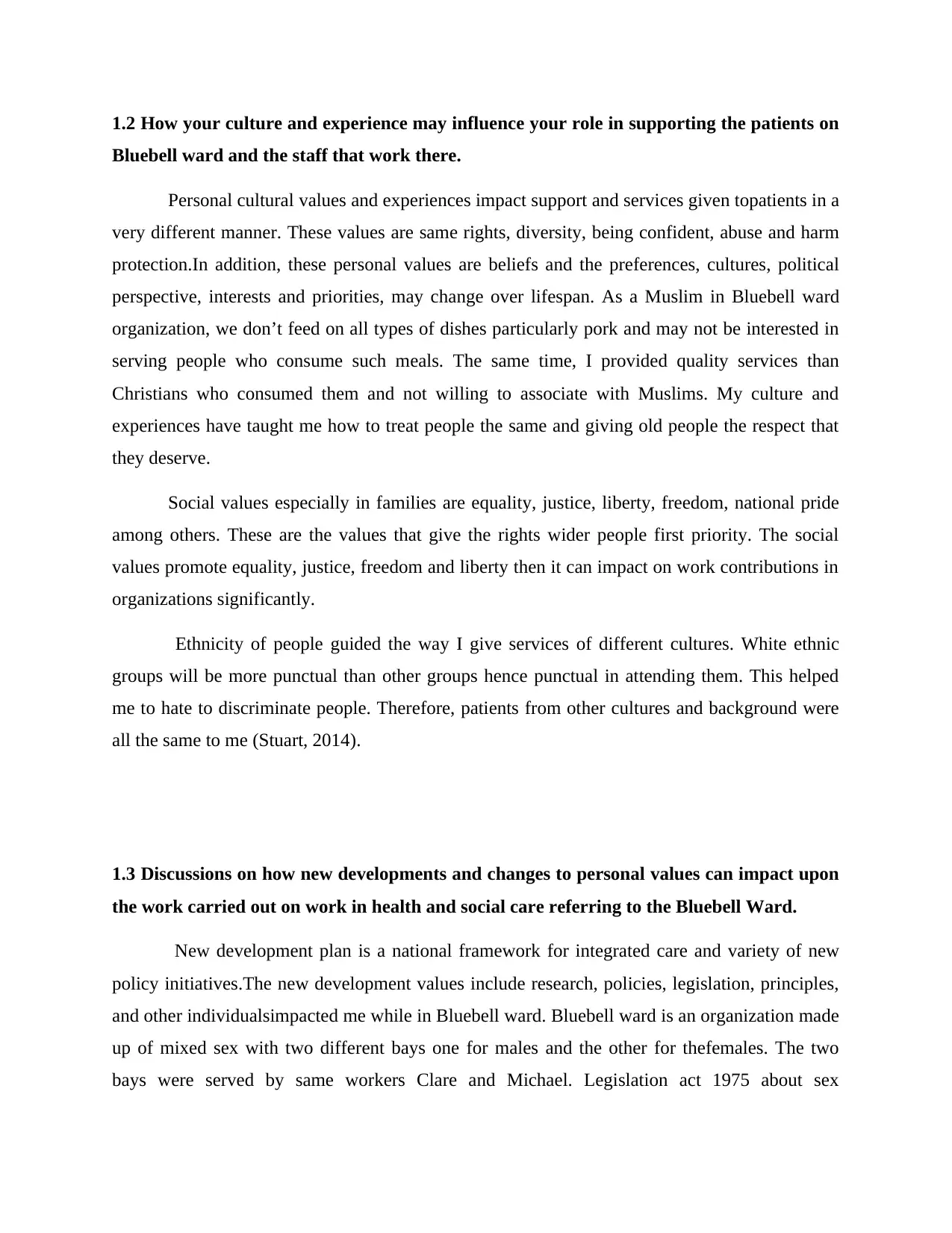
1.2 How your culture and experience may influence your role in supporting the patients on
Bluebell ward and the staff that work there.
Personal cultural values and experiences impact support and services given topatients in a
very different manner. These values are same rights, diversity, being confident, abuse and harm
protection.In addition, these personal values are beliefs and the preferences, cultures, political
perspective, interests and priorities, may change over lifespan. As a Muslim in Bluebell ward
organization, we don’t feed on all types of dishes particularly pork and may not be interested in
serving people who consume such meals. The same time, I provided quality services than
Christians who consumed them and not willing to associate with Muslims. My culture and
experiences have taught me how to treat people the same and giving old people the respect that
they deserve.
Social values especially in families are equality, justice, liberty, freedom, national pride
among others. These are the values that give the rights wider people first priority. The social
values promote equality, justice, freedom and liberty then it can impact on work contributions in
organizations significantly.
Ethnicity of people guided the way I give services of different cultures. White ethnic
groups will be more punctual than other groups hence punctual in attending them. This helped
me to hate to discriminate people. Therefore, patients from other cultures and background were
all the same to me (Stuart, 2014).
1.3 Discussions on how new developments and changes to personal values can impact upon
the work carried out on work in health and social care referring to the Bluebell Ward.
New development plan is a national framework for integrated care and variety of new
policy initiatives.The new development values include research, policies, legislation, principles,
and other individualsimpacted me while in Bluebell ward. Bluebell ward is an organization made
up of mixed sex with two different bays one for males and the other for thefemales. The two
bays were served by same workers Clare and Michael. Legislation act 1975 about sex
Bluebell ward and the staff that work there.
Personal cultural values and experiences impact support and services given topatients in a
very different manner. These values are same rights, diversity, being confident, abuse and harm
protection.In addition, these personal values are beliefs and the preferences, cultures, political
perspective, interests and priorities, may change over lifespan. As a Muslim in Bluebell ward
organization, we don’t feed on all types of dishes particularly pork and may not be interested in
serving people who consume such meals. The same time, I provided quality services than
Christians who consumed them and not willing to associate with Muslims. My culture and
experiences have taught me how to treat people the same and giving old people the respect that
they deserve.
Social values especially in families are equality, justice, liberty, freedom, national pride
among others. These are the values that give the rights wider people first priority. The social
values promote equality, justice, freedom and liberty then it can impact on work contributions in
organizations significantly.
Ethnicity of people guided the way I give services of different cultures. White ethnic
groups will be more punctual than other groups hence punctual in attending them. This helped
me to hate to discriminate people. Therefore, patients from other cultures and background were
all the same to me (Stuart, 2014).
1.3 Discussions on how new developments and changes to personal values can impact upon
the work carried out on work in health and social care referring to the Bluebell Ward.
New development plan is a national framework for integrated care and variety of new
policy initiatives.The new development values include research, policies, legislation, principles,
and other individualsimpacted me while in Bluebell ward. Bluebell ward is an organization made
up of mixed sex with two different bays one for males and the other for thefemales. The two
bays were served by same workers Clare and Michael. Legislation act 1975 about sex
⊘ This is a preview!⊘
Do you want full access?
Subscribe today to unlock all pages.

Trusted by 1+ million students worldwide
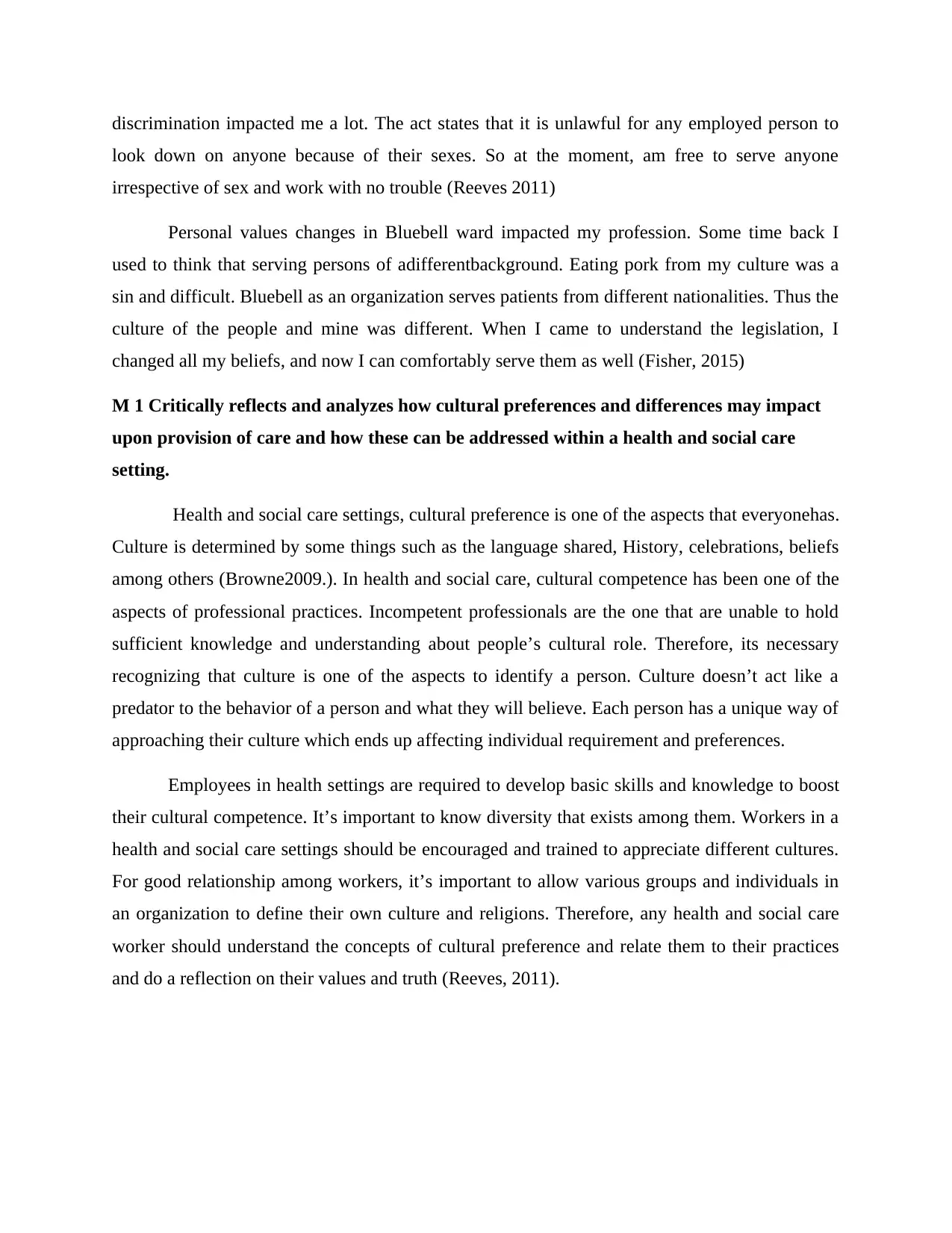
discrimination impacted me a lot. The act states that it is unlawful for any employed person to
look down on anyone because of their sexes. So at the moment, am free to serve anyone
irrespective of sex and work with no trouble (Reeves 2011)
Personal values changes in Bluebell ward impacted my profession. Some time back I
used to think that serving persons of adifferentbackground. Eating pork from my culture was a
sin and difficult. Bluebell as an organization serves patients from different nationalities. Thus the
culture of the people and mine was different. When I came to understand the legislation, I
changed all my beliefs, and now I can comfortably serve them as well (Fisher, 2015)
M 1 Critically reflects and analyzes how cultural preferences and differences may impact
upon provision of care and how these can be addressed within a health and social care
setting.
Health and social care settings, cultural preference is one of the aspects that everyonehas.
Culture is determined by some things such as the language shared, History, celebrations, beliefs
among others (Browne2009.). In health and social care, cultural competence has been one of the
aspects of professional practices. Incompetent professionals are the one that are unable to hold
sufficient knowledge and understanding about people’s cultural role. Therefore, its necessary
recognizing that culture is one of the aspects to identify a person. Culture doesn’t act like a
predator to the behavior of a person and what they will believe. Each person has a unique way of
approaching their culture which ends up affecting individual requirement and preferences.
Employees in health settings are required to develop basic skills and knowledge to boost
their cultural competence. It’s important to know diversity that exists among them. Workers in a
health and social care settings should be encouraged and trained to appreciate different cultures.
For good relationship among workers, it’s important to allow various groups and individuals in
an organization to define their own culture and religions. Therefore, any health and social care
worker should understand the concepts of cultural preference and relate them to their practices
and do a reflection on their values and truth (Reeves, 2011).
look down on anyone because of their sexes. So at the moment, am free to serve anyone
irrespective of sex and work with no trouble (Reeves 2011)
Personal values changes in Bluebell ward impacted my profession. Some time back I
used to think that serving persons of adifferentbackground. Eating pork from my culture was a
sin and difficult. Bluebell as an organization serves patients from different nationalities. Thus the
culture of the people and mine was different. When I came to understand the legislation, I
changed all my beliefs, and now I can comfortably serve them as well (Fisher, 2015)
M 1 Critically reflects and analyzes how cultural preferences and differences may impact
upon provision of care and how these can be addressed within a health and social care
setting.
Health and social care settings, cultural preference is one of the aspects that everyonehas.
Culture is determined by some things such as the language shared, History, celebrations, beliefs
among others (Browne2009.). In health and social care, cultural competence has been one of the
aspects of professional practices. Incompetent professionals are the one that are unable to hold
sufficient knowledge and understanding about people’s cultural role. Therefore, its necessary
recognizing that culture is one of the aspects to identify a person. Culture doesn’t act like a
predator to the behavior of a person and what they will believe. Each person has a unique way of
approaching their culture which ends up affecting individual requirement and preferences.
Employees in health settings are required to develop basic skills and knowledge to boost
their cultural competence. It’s important to know diversity that exists among them. Workers in a
health and social care settings should be encouraged and trained to appreciate different cultures.
For good relationship among workers, it’s important to allow various groups and individuals in
an organization to define their own culture and religions. Therefore, any health and social care
worker should understand the concepts of cultural preference and relate them to their practices
and do a reflection on their values and truth (Reeves, 2011).
Paraphrase This Document
Need a fresh take? Get an instant paraphrase of this document with our AI Paraphraser
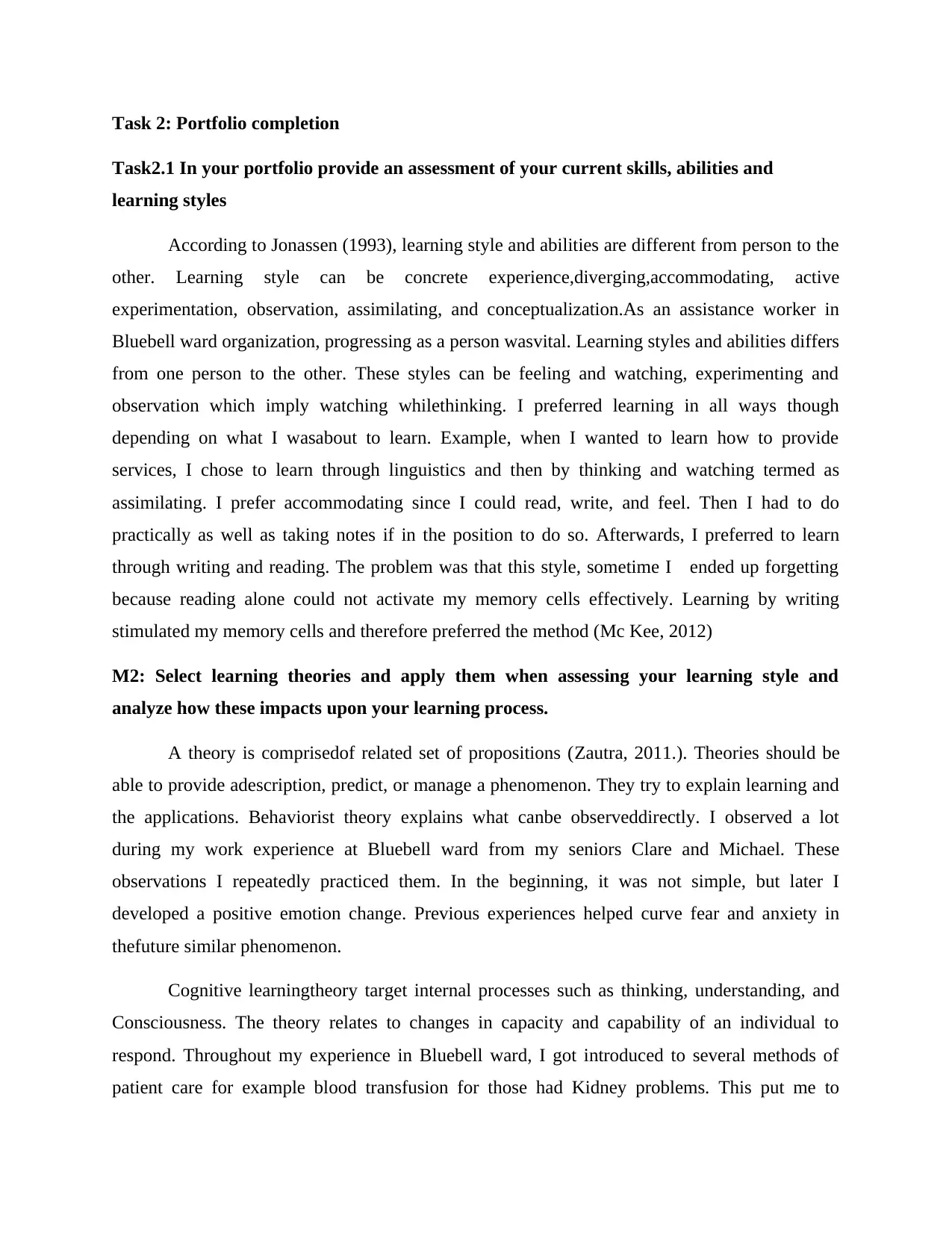
Task 2: Portfolio completion
Task2.1 In your portfolio provide an assessment of your current skills, abilities and
learning styles
According to Jonassen (1993), learning style and abilities are different from person to the
other. Learning style can be concrete experience,diverging,accommodating, active
experimentation, observation, assimilating, and conceptualization.As an assistance worker in
Bluebell ward organization, progressing as a person wasvital. Learning styles and abilities differs
from one person to the other. These styles can be feeling and watching, experimenting and
observation which imply watching whilethinking. I preferred learning in all ways though
depending on what I wasabout to learn. Example, when I wanted to learn how to provide
services, I chose to learn through linguistics and then by thinking and watching termed as
assimilating. I prefer accommodating since I could read, write, and feel. Then I had to do
practically as well as taking notes if in the position to do so. Afterwards, I preferred to learn
through writing and reading. The problem was that this style, sometime I ended up forgetting
because reading alone could not activate my memory cells effectively. Learning by writing
stimulated my memory cells and therefore preferred the method (Mc Kee, 2012)
M2: Select learning theories and apply them when assessing your learning style and
analyze how these impacts upon your learning process.
A theory is comprisedof related set of propositions (Zautra, 2011.). Theories should be
able to provide adescription, predict, or manage a phenomenon. They try to explain learning and
the applications. Behaviorist theory explains what canbe observeddirectly. I observed a lot
during my work experience at Bluebell ward from my seniors Clare and Michael. These
observations I repeatedly practiced them. In the beginning, it was not simple, but later I
developed a positive emotion change. Previous experiences helped curve fear and anxiety in
thefuture similar phenomenon.
Cognitive learningtheory target internal processes such as thinking, understanding, and
Consciousness. The theory relates to changes in capacity and capability of an individual to
respond. Throughout my experience in Bluebell ward, I got introduced to several methods of
patient care for example blood transfusion for those had Kidney problems. This put me to
Task2.1 In your portfolio provide an assessment of your current skills, abilities and
learning styles
According to Jonassen (1993), learning style and abilities are different from person to the
other. Learning style can be concrete experience,diverging,accommodating, active
experimentation, observation, assimilating, and conceptualization.As an assistance worker in
Bluebell ward organization, progressing as a person wasvital. Learning styles and abilities differs
from one person to the other. These styles can be feeling and watching, experimenting and
observation which imply watching whilethinking. I preferred learning in all ways though
depending on what I wasabout to learn. Example, when I wanted to learn how to provide
services, I chose to learn through linguistics and then by thinking and watching termed as
assimilating. I prefer accommodating since I could read, write, and feel. Then I had to do
practically as well as taking notes if in the position to do so. Afterwards, I preferred to learn
through writing and reading. The problem was that this style, sometime I ended up forgetting
because reading alone could not activate my memory cells effectively. Learning by writing
stimulated my memory cells and therefore preferred the method (Mc Kee, 2012)
M2: Select learning theories and apply them when assessing your learning style and
analyze how these impacts upon your learning process.
A theory is comprisedof related set of propositions (Zautra, 2011.). Theories should be
able to provide adescription, predict, or manage a phenomenon. They try to explain learning and
the applications. Behaviorist theory explains what canbe observeddirectly. I observed a lot
during my work experience at Bluebell ward from my seniors Clare and Michael. These
observations I repeatedly practiced them. In the beginning, it was not simple, but later I
developed a positive emotion change. Previous experiences helped curve fear and anxiety in
thefuture similar phenomenon.
Cognitive learningtheory target internal processes such as thinking, understanding, and
Consciousness. The theory relates to changes in capacity and capability of an individual to
respond. Throughout my experience in Bluebell ward, I got introduced to several methods of
patient care for example blood transfusion for those had Kidney problems. This put me to
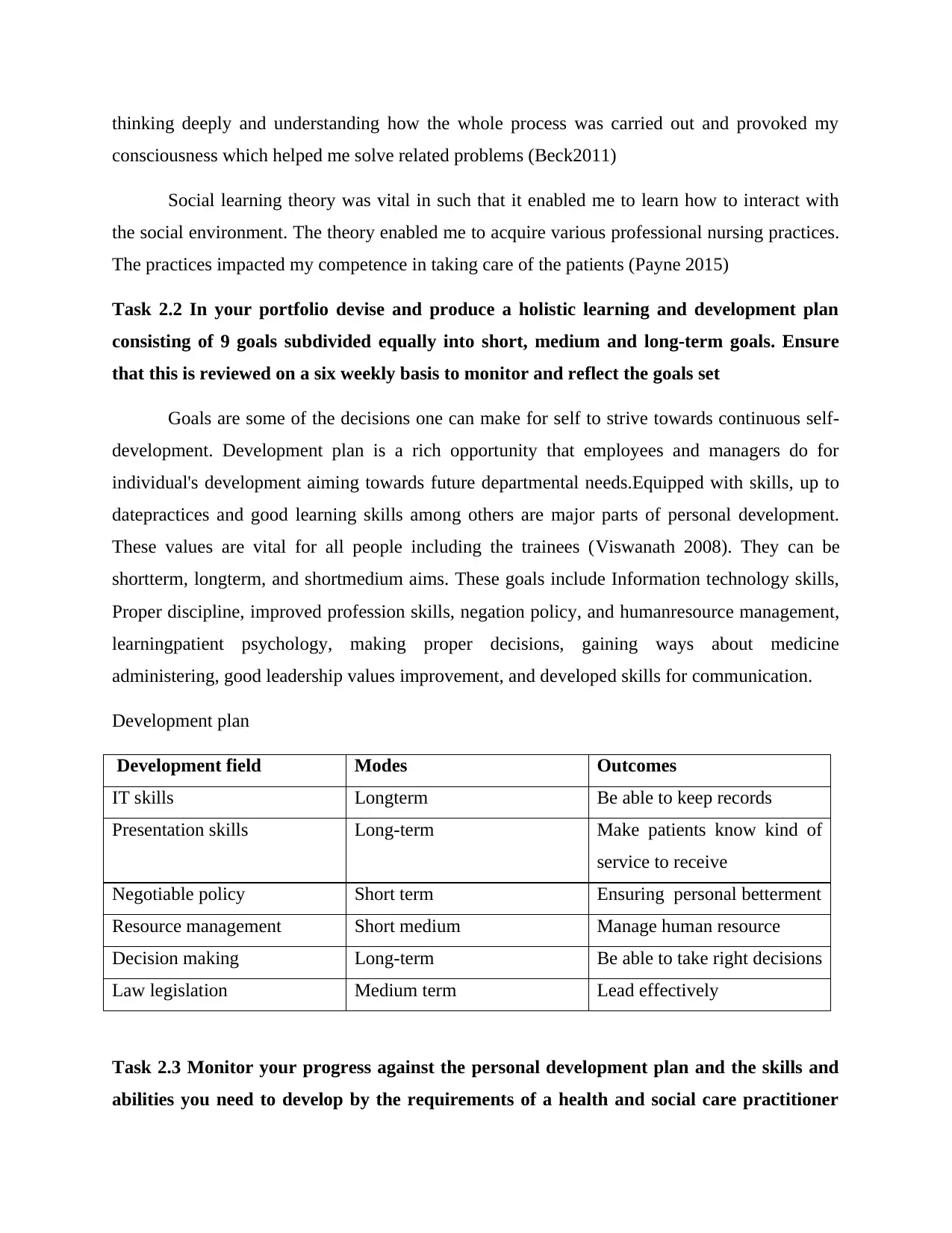
thinking deeply and understanding how the whole process was carried out and provoked my
consciousness which helped me solve related problems (Beck2011)
Social learning theory was vital in such that it enabled me to learn how to interact with
the social environment. The theory enabled me to acquire various professional nursing practices.
The practices impacted my competence in taking care of the patients (Payne 2015)
Task 2.2 In your portfolio devise and produce a holistic learning and development plan
consisting of 9 goals subdivided equally into short, medium and long-term goals. Ensure
that this is reviewed on a six weekly basis to monitor and reflect the goals set
Goals are some of the decisions one can make for self to strive towards continuous self-
development. Development plan is a rich opportunity that employees and managers do for
individual's development aiming towards future departmental needs.Equipped with skills, up to
datepractices and good learning skills among others are major parts of personal development.
These values are vital for all people including the trainees (Viswanath 2008). They can be
shortterm, longterm, and shortmedium aims. These goals include Information technology skills,
Proper discipline, improved profession skills, negation policy, and humanresource management,
learningpatient psychology, making proper decisions, gaining ways about medicine
administering, good leadership values improvement, and developed skills for communication.
Development plan
Development field Modes Outcomes
IT skills Longterm Be able to keep records
Presentation skills Long-term Make patients know kind of
service to receive
Negotiable policy Short term Ensuring personal betterment
Resource management Short medium Manage human resource
Decision making Long-term Be able to take right decisions
Law legislation Medium term Lead effectively
Task 2.3 Monitor your progress against the personal development plan and the skills and
abilities you need to develop by the requirements of a health and social care practitioner
consciousness which helped me solve related problems (Beck2011)
Social learning theory was vital in such that it enabled me to learn how to interact with
the social environment. The theory enabled me to acquire various professional nursing practices.
The practices impacted my competence in taking care of the patients (Payne 2015)
Task 2.2 In your portfolio devise and produce a holistic learning and development plan
consisting of 9 goals subdivided equally into short, medium and long-term goals. Ensure
that this is reviewed on a six weekly basis to monitor and reflect the goals set
Goals are some of the decisions one can make for self to strive towards continuous self-
development. Development plan is a rich opportunity that employees and managers do for
individual's development aiming towards future departmental needs.Equipped with skills, up to
datepractices and good learning skills among others are major parts of personal development.
These values are vital for all people including the trainees (Viswanath 2008). They can be
shortterm, longterm, and shortmedium aims. These goals include Information technology skills,
Proper discipline, improved profession skills, negation policy, and humanresource management,
learningpatient psychology, making proper decisions, gaining ways about medicine
administering, good leadership values improvement, and developed skills for communication.
Development plan
Development field Modes Outcomes
IT skills Longterm Be able to keep records
Presentation skills Long-term Make patients know kind of
service to receive
Negotiable policy Short term Ensuring personal betterment
Resource management Short medium Manage human resource
Decision making Long-term Be able to take right decisions
Law legislation Medium term Lead effectively
Task 2.3 Monitor your progress against the personal development plan and the skills and
abilities you need to develop by the requirements of a health and social care practitioner
⊘ This is a preview!⊘
Do you want full access?
Subscribe today to unlock all pages.

Trusted by 1+ million students worldwide
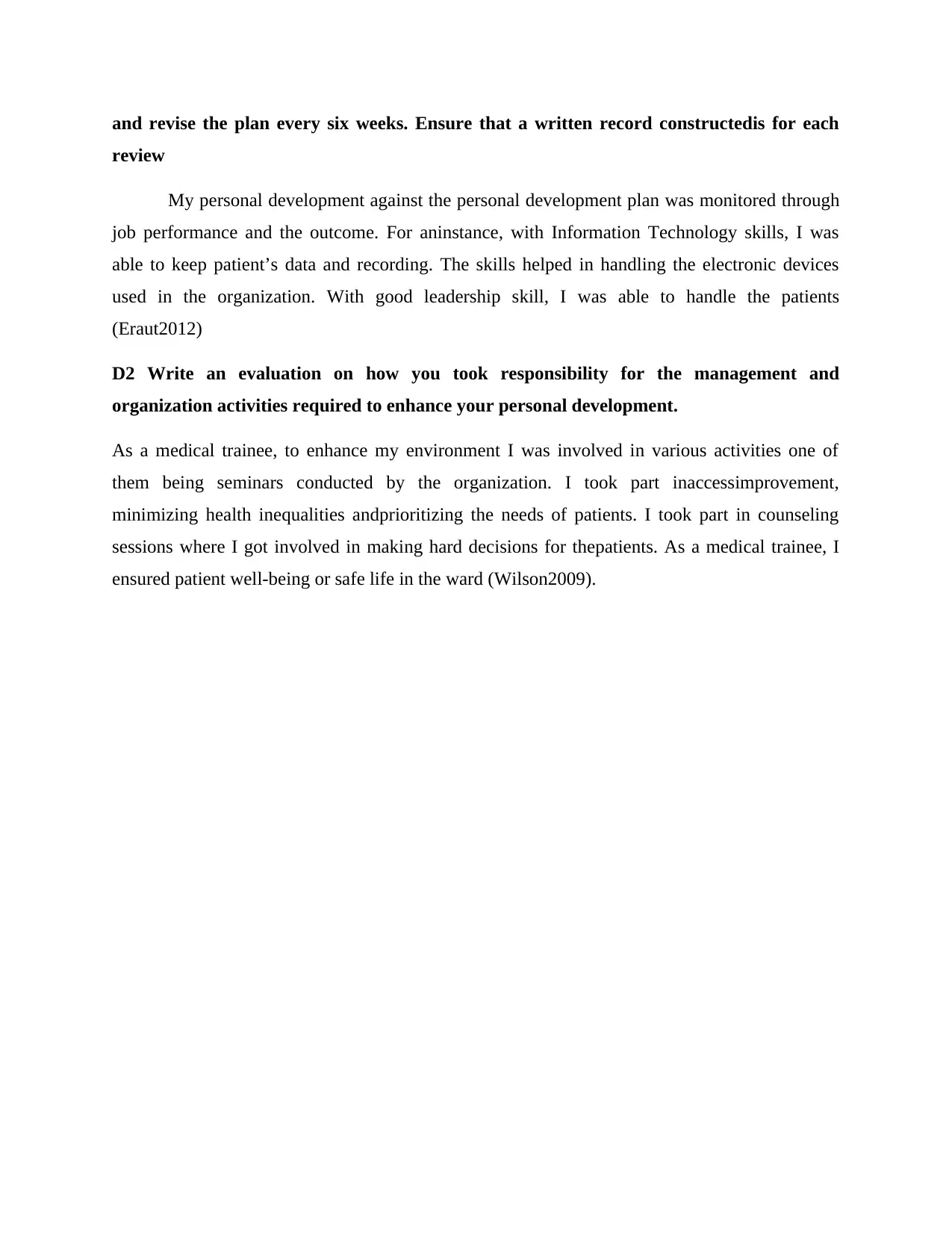
and revise the plan every six weeks. Ensure that a written record constructedis for each
review
My personal development against the personal development plan was monitored through
job performance and the outcome. For aninstance, with Information Technology skills, I was
able to keep patient’s data and recording. The skills helped in handling the electronic devices
used in the organization. With good leadership skill, I was able to handle the patients
(Eraut2012)
D2 Write an evaluation on how you took responsibility for the management and
organization activities required to enhance your personal development.
As a medical trainee, to enhance my environment I was involved in various activities one of
them being seminars conducted by the organization. I took part inaccessimprovement,
minimizing health inequalities andprioritizing the needs of patients. I took part in counseling
sessions where I got involved in making hard decisions for thepatients. As a medical trainee, I
ensured patient well-being or safe life in the ward (Wilson2009).
review
My personal development against the personal development plan was monitored through
job performance and the outcome. For aninstance, with Information Technology skills, I was
able to keep patient’s data and recording. The skills helped in handling the electronic devices
used in the organization. With good leadership skill, I was able to handle the patients
(Eraut2012)
D2 Write an evaluation on how you took responsibility for the management and
organization activities required to enhance your personal development.
As a medical trainee, to enhance my environment I was involved in various activities one of
them being seminars conducted by the organization. I took part inaccessimprovement,
minimizing health inequalities andprioritizing the needs of patients. I took part in counseling
sessions where I got involved in making hard decisions for thepatients. As a medical trainee, I
ensured patient well-being or safe life in the ward (Wilson2009).
Paraphrase This Document
Need a fresh take? Get an instant paraphrase of this document with our AI Paraphraser
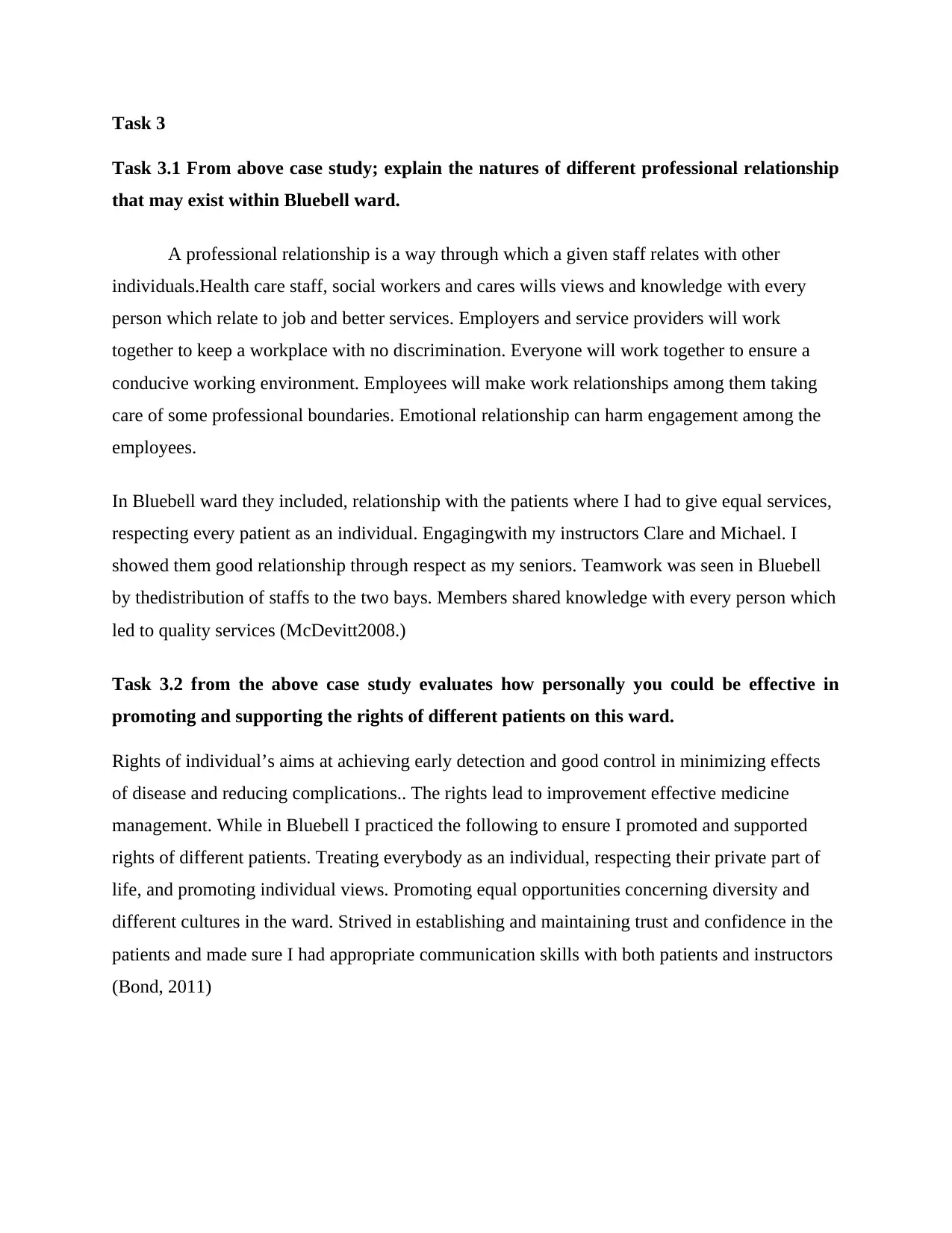
Task 3
Task 3.1 From above case study; explain the natures of different professional relationship
that may exist within Bluebell ward.
A professional relationship is a way through which a given staff relates with other
individuals.Health care staff, social workers and cares wills views and knowledge with every
person which relate to job and better services. Employers and service providers will work
together to keep a workplace with no discrimination. Everyone will work together to ensure a
conducive working environment. Employees will make work relationships among them taking
care of some professional boundaries. Emotional relationship can harm engagement among the
employees.
In Bluebell ward they included, relationship with the patients where I had to give equal services,
respecting every patient as an individual. Engagingwith my instructors Clare and Michael. I
showed them good relationship through respect as my seniors. Teamwork was seen in Bluebell
by thedistribution of staffs to the two bays. Members shared knowledge with every person which
led to quality services (McDevitt2008.)
Task 3.2 from the above case study evaluates how personally you could be effective in
promoting and supporting the rights of different patients on this ward.
Rights of individual’s aims at achieving early detection and good control in minimizing effects
of disease and reducing complications.. The rights lead to improvement effective medicine
management. While in Bluebell I practiced the following to ensure I promoted and supported
rights of different patients. Treating everybody as an individual, respecting their private part of
life, and promoting individual views. Promoting equal opportunities concerning diversity and
different cultures in the ward. Strived in establishing and maintaining trust and confidence in the
patients and made sure I had appropriate communication skills with both patients and instructors
(Bond, 2011)
Task 3.1 From above case study; explain the natures of different professional relationship
that may exist within Bluebell ward.
A professional relationship is a way through which a given staff relates with other
individuals.Health care staff, social workers and cares wills views and knowledge with every
person which relate to job and better services. Employers and service providers will work
together to keep a workplace with no discrimination. Everyone will work together to ensure a
conducive working environment. Employees will make work relationships among them taking
care of some professional boundaries. Emotional relationship can harm engagement among the
employees.
In Bluebell ward they included, relationship with the patients where I had to give equal services,
respecting every patient as an individual. Engagingwith my instructors Clare and Michael. I
showed them good relationship through respect as my seniors. Teamwork was seen in Bluebell
by thedistribution of staffs to the two bays. Members shared knowledge with every person which
led to quality services (McDevitt2008.)
Task 3.2 from the above case study evaluates how personally you could be effective in
promoting and supporting the rights of different patients on this ward.
Rights of individual’s aims at achieving early detection and good control in minimizing effects
of disease and reducing complications.. The rights lead to improvement effective medicine
management. While in Bluebell I practiced the following to ensure I promoted and supported
rights of different patients. Treating everybody as an individual, respecting their private part of
life, and promoting individual views. Promoting equal opportunities concerning diversity and
different cultures in the ward. Strived in establishing and maintaining trust and confidence in the
patients and made sure I had appropriate communication skills with both patients and instructors
(Bond, 2011)
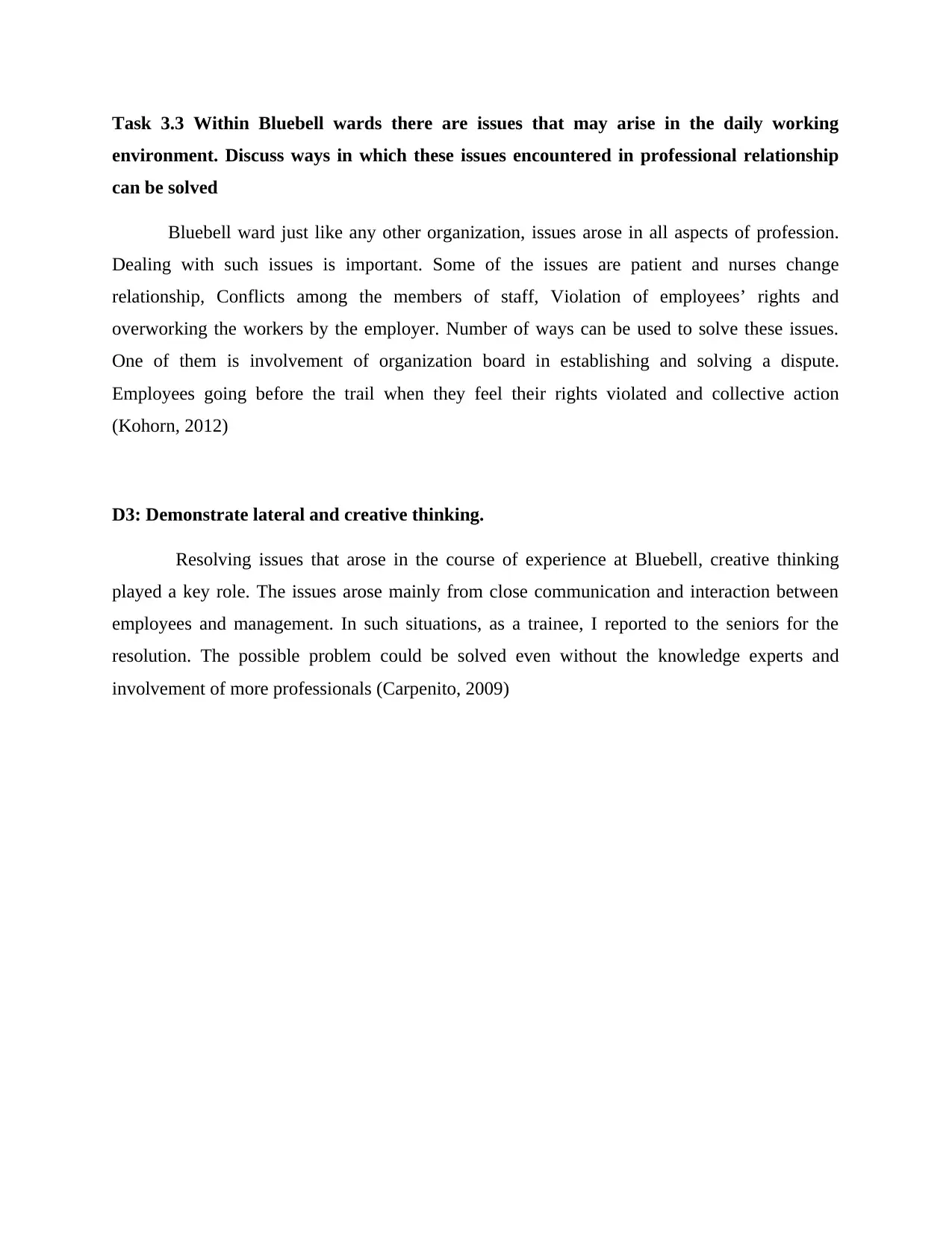
Task 3.3 Within Bluebell wards there are issues that may arise in the daily working
environment. Discuss ways in which these issues encountered in professional relationship
can be solved
Bluebell ward just like any other organization, issues arose in all aspects of profession.
Dealing with such issues is important. Some of the issues are patient and nurses change
relationship, Conflicts among the members of staff, Violation of employees’ rights and
overworking the workers by the employer. Number of ways can be used to solve these issues.
One of them is involvement of organization board in establishing and solving a dispute.
Employees going before the trail when they feel their rights violated and collective action
(Kohorn, 2012)
D3: Demonstrate lateral and creative thinking.
Resolving issues that arose in the course of experience at Bluebell, creative thinking
played a key role. The issues arose mainly from close communication and interaction between
employees and management. In such situations, as a trainee, I reported to the seniors for the
resolution. The possible problem could be solved even without the knowledge experts and
involvement of more professionals (Carpenito, 2009)
environment. Discuss ways in which these issues encountered in professional relationship
can be solved
Bluebell ward just like any other organization, issues arose in all aspects of profession.
Dealing with such issues is important. Some of the issues are patient and nurses change
relationship, Conflicts among the members of staff, Violation of employees’ rights and
overworking the workers by the employer. Number of ways can be used to solve these issues.
One of them is involvement of organization board in establishing and solving a dispute.
Employees going before the trail when they feel their rights violated and collective action
(Kohorn, 2012)
D3: Demonstrate lateral and creative thinking.
Resolving issues that arose in the course of experience at Bluebell, creative thinking
played a key role. The issues arose mainly from close communication and interaction between
employees and management. In such situations, as a trainee, I reported to the seniors for the
resolution. The possible problem could be solved even without the knowledge experts and
involvement of more professionals (Carpenito, 2009)
⊘ This is a preview!⊘
Do you want full access?
Subscribe today to unlock all pages.

Trusted by 1+ million students worldwide
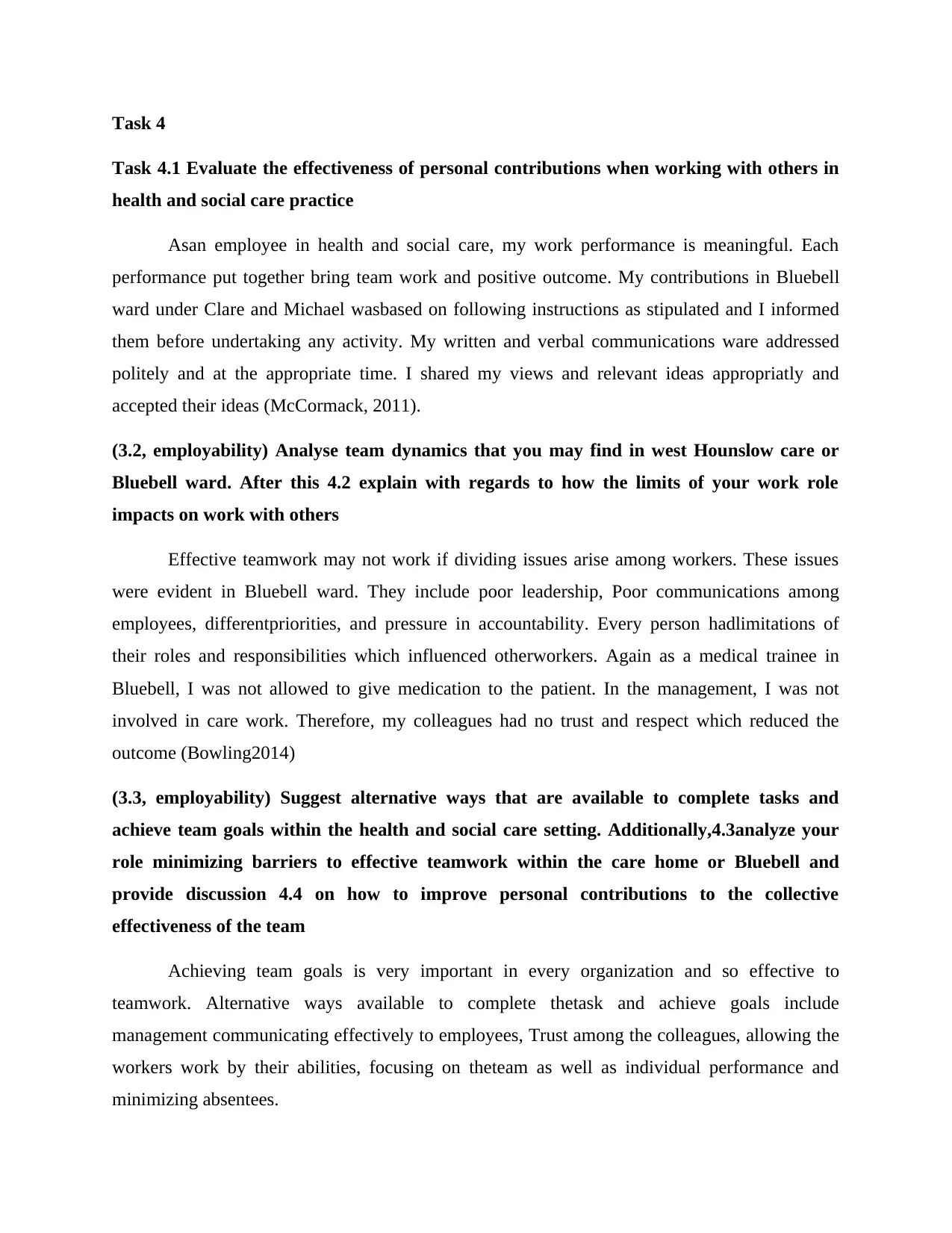
Task 4
Task 4.1 Evaluate the effectiveness of personal contributions when working with others in
health and social care practice
Asan employee in health and social care, my work performance is meaningful. Each
performance put together bring team work and positive outcome. My contributions in Bluebell
ward under Clare and Michael wasbased on following instructions as stipulated and I informed
them before undertaking any activity. My written and verbal communications ware addressed
politely and at the appropriate time. I shared my views and relevant ideas appropriatly and
accepted their ideas (McCormack, 2011).
(3.2, employability) Analyse team dynamics that you may find in west Hounslow care or
Bluebell ward. After this 4.2 explain with regards to how the limits of your work role
impacts on work with others
Effective teamwork may not work if dividing issues arise among workers. These issues
were evident in Bluebell ward. They include poor leadership, Poor communications among
employees, differentpriorities, and pressure in accountability. Every person hadlimitations of
their roles and responsibilities which influenced otherworkers. Again as a medical trainee in
Bluebell, I was not allowed to give medication to the patient. In the management, I was not
involved in care work. Therefore, my colleagues had no trust and respect which reduced the
outcome (Bowling2014)
(3.3, employability) Suggest alternative ways that are available to complete tasks and
achieve team goals within the health and social care setting. Additionally,4.3analyze your
role minimizing barriers to effective teamwork within the care home or Bluebell and
provide discussion 4.4 on how to improve personal contributions to the collective
effectiveness of the team
Achieving team goals is very important in every organization and so effective to
teamwork. Alternative ways available to complete thetask and achieve goals include
management communicating effectively to employees, Trust among the colleagues, allowing the
workers work by their abilities, focusing on theteam as well as individual performance and
minimizing absentees.
Task 4.1 Evaluate the effectiveness of personal contributions when working with others in
health and social care practice
Asan employee in health and social care, my work performance is meaningful. Each
performance put together bring team work and positive outcome. My contributions in Bluebell
ward under Clare and Michael wasbased on following instructions as stipulated and I informed
them before undertaking any activity. My written and verbal communications ware addressed
politely and at the appropriate time. I shared my views and relevant ideas appropriatly and
accepted their ideas (McCormack, 2011).
(3.2, employability) Analyse team dynamics that you may find in west Hounslow care or
Bluebell ward. After this 4.2 explain with regards to how the limits of your work role
impacts on work with others
Effective teamwork may not work if dividing issues arise among workers. These issues
were evident in Bluebell ward. They include poor leadership, Poor communications among
employees, differentpriorities, and pressure in accountability. Every person hadlimitations of
their roles and responsibilities which influenced otherworkers. Again as a medical trainee in
Bluebell, I was not allowed to give medication to the patient. In the management, I was not
involved in care work. Therefore, my colleagues had no trust and respect which reduced the
outcome (Bowling2014)
(3.3, employability) Suggest alternative ways that are available to complete tasks and
achieve team goals within the health and social care setting. Additionally,4.3analyze your
role minimizing barriers to effective teamwork within the care home or Bluebell and
provide discussion 4.4 on how to improve personal contributions to the collective
effectiveness of the team
Achieving team goals is very important in every organization and so effective to
teamwork. Alternative ways available to complete thetask and achieve goals include
management communicating effectively to employees, Trust among the colleagues, allowing the
workers work by their abilities, focusing on theteam as well as individual performance and
minimizing absentees.
Paraphrase This Document
Need a fresh take? Get an instant paraphrase of this document with our AI Paraphraser
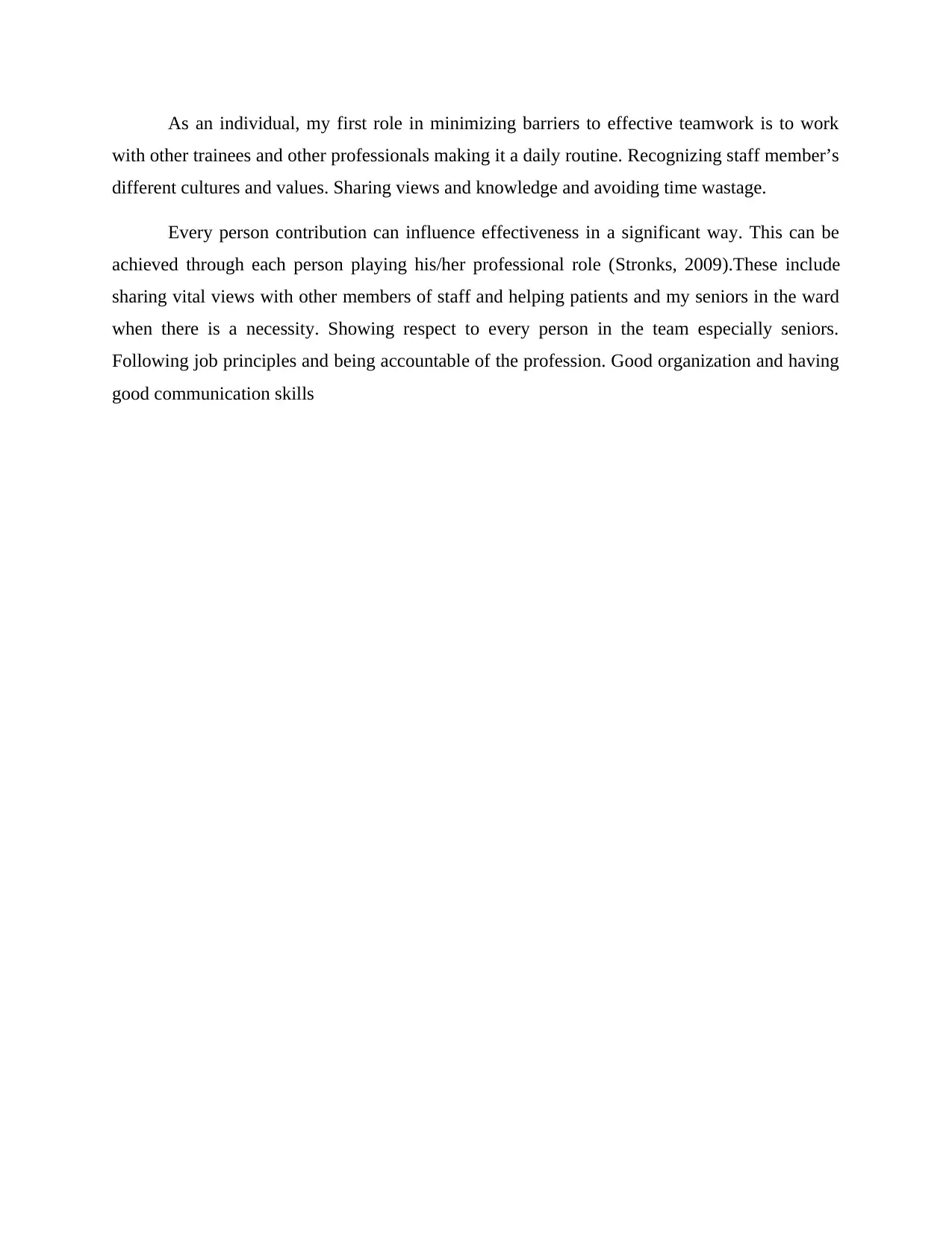
As an individual, my first role in minimizing barriers to effective teamwork is to work
with other trainees and other professionals making it a daily routine. Recognizing staff member’s
different cultures and values. Sharing views and knowledge and avoiding time wastage.
Every person contribution can influence effectiveness in a significant way. This can be
achieved through each person playing his/her professional role (Stronks, 2009).These include
sharing vital views with other members of staff and helping patients and my seniors in the ward
when there is a necessity. Showing respect to every person in the team especially seniors.
Following job principles and being accountable of the profession. Good organization and having
good communication skills
with other trainees and other professionals making it a daily routine. Recognizing staff member’s
different cultures and values. Sharing views and knowledge and avoiding time wastage.
Every person contribution can influence effectiveness in a significant way. This can be
achieved through each person playing his/her professional role (Stronks, 2009).These include
sharing vital views with other members of staff and helping patients and my seniors in the ward
when there is a necessity. Showing respect to every person in the team especially seniors.
Following job principles and being accountable of the profession. Good organization and having
good communication skills
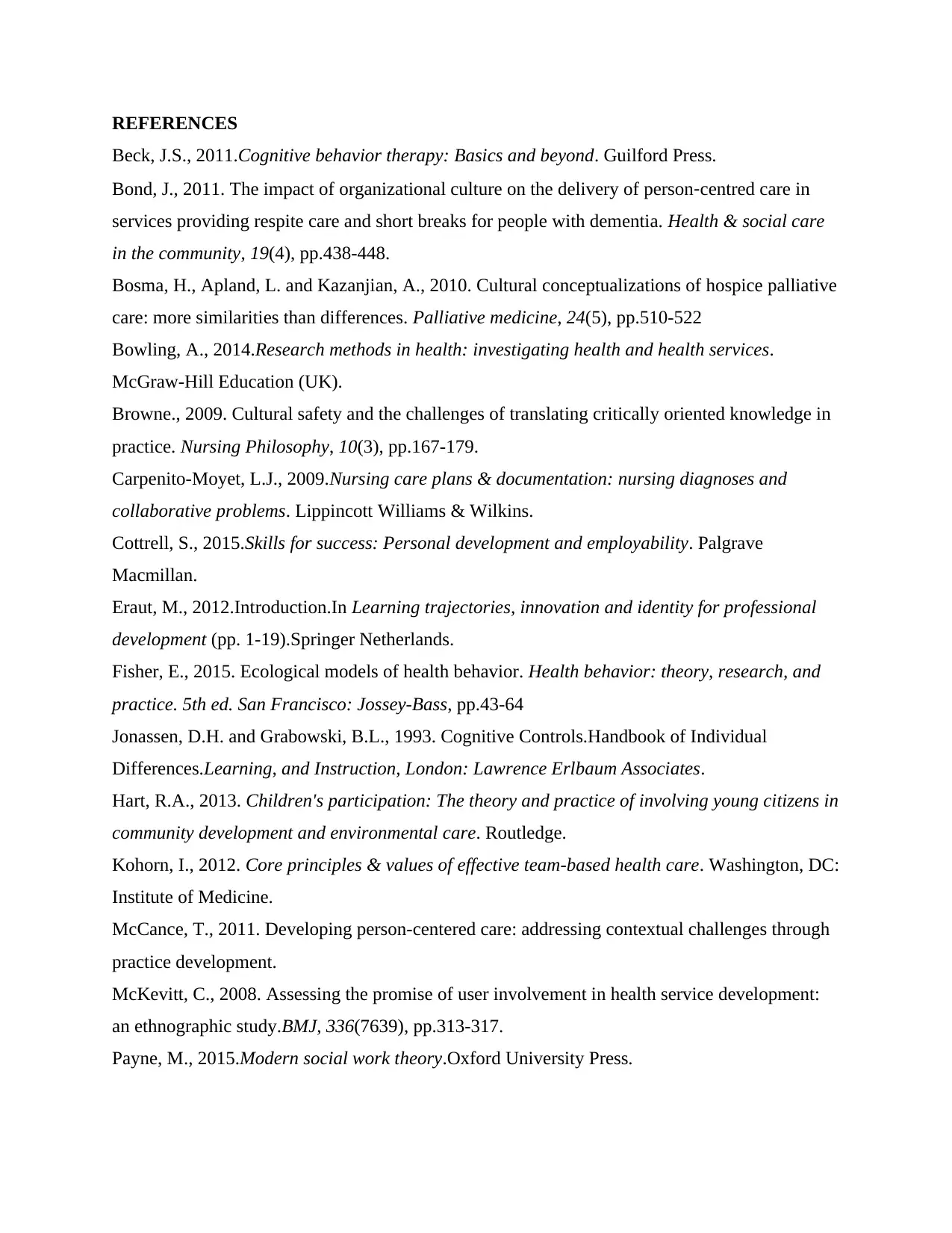
REFERENCES
Beck, J.S., 2011.Cognitive behavior therapy: Basics and beyond. Guilford Press.
Bond, J., 2011. The impact of organizational culture on the delivery of person‐centred care in
services providing respite care and short breaks for people with dementia. Health & social care
in the community, 19(4), pp.438-448.
Bosma, H., Apland, L. and Kazanjian, A., 2010. Cultural conceptualizations of hospice palliative
care: more similarities than differences. Palliative medicine, 24(5), pp.510-522
Bowling, A., 2014.Research methods in health: investigating health and health services.
McGraw-Hill Education (UK).
Browne., 2009. Cultural safety and the challenges of translating critically oriented knowledge in
practice. Nursing Philosophy, 10(3), pp.167-179.
Carpenito-Moyet, L.J., 2009.Nursing care plans & documentation: nursing diagnoses and
collaborative problems. Lippincott Williams & Wilkins.
Cottrell, S., 2015.Skills for success: Personal development and employability. Palgrave
Macmillan.
Eraut, M., 2012.Introduction.In Learning trajectories, innovation and identity for professional
development (pp. 1-19).Springer Netherlands.
Fisher, E., 2015. Ecological models of health behavior. Health behavior: theory, research, and
practice. 5th ed. San Francisco: Jossey-Bass, pp.43-64
Jonassen, D.H. and Grabowski, B.L., 1993. Cognitive Controls.Handbook of Individual
Differences.Learning, and Instruction, London: Lawrence Erlbaum Associates.
Hart, R.A., 2013. Children's participation: The theory and practice of involving young citizens in
community development and environmental care. Routledge.
Kohorn, I., 2012. Core principles & values of effective team-based health care. Washington, DC:
Institute of Medicine.
McCance, T., 2011. Developing person-centered care: addressing contextual challenges through
practice development.
McKevitt, C., 2008. Assessing the promise of user involvement in health service development:
an ethnographic study.BMJ, 336(7639), pp.313-317.
Payne, M., 2015.Modern social work theory.Oxford University Press.
Beck, J.S., 2011.Cognitive behavior therapy: Basics and beyond. Guilford Press.
Bond, J., 2011. The impact of organizational culture on the delivery of person‐centred care in
services providing respite care and short breaks for people with dementia. Health & social care
in the community, 19(4), pp.438-448.
Bosma, H., Apland, L. and Kazanjian, A., 2010. Cultural conceptualizations of hospice palliative
care: more similarities than differences. Palliative medicine, 24(5), pp.510-522
Bowling, A., 2014.Research methods in health: investigating health and health services.
McGraw-Hill Education (UK).
Browne., 2009. Cultural safety and the challenges of translating critically oriented knowledge in
practice. Nursing Philosophy, 10(3), pp.167-179.
Carpenito-Moyet, L.J., 2009.Nursing care plans & documentation: nursing diagnoses and
collaborative problems. Lippincott Williams & Wilkins.
Cottrell, S., 2015.Skills for success: Personal development and employability. Palgrave
Macmillan.
Eraut, M., 2012.Introduction.In Learning trajectories, innovation and identity for professional
development (pp. 1-19).Springer Netherlands.
Fisher, E., 2015. Ecological models of health behavior. Health behavior: theory, research, and
practice. 5th ed. San Francisco: Jossey-Bass, pp.43-64
Jonassen, D.H. and Grabowski, B.L., 1993. Cognitive Controls.Handbook of Individual
Differences.Learning, and Instruction, London: Lawrence Erlbaum Associates.
Hart, R.A., 2013. Children's participation: The theory and practice of involving young citizens in
community development and environmental care. Routledge.
Kohorn, I., 2012. Core principles & values of effective team-based health care. Washington, DC:
Institute of Medicine.
McCance, T., 2011. Developing person-centered care: addressing contextual challenges through
practice development.
McKevitt, C., 2008. Assessing the promise of user involvement in health service development:
an ethnographic study.BMJ, 336(7639), pp.313-317.
Payne, M., 2015.Modern social work theory.Oxford University Press.
⊘ This is a preview!⊘
Do you want full access?
Subscribe today to unlock all pages.

Trusted by 1+ million students worldwide
1 out of 14
Related Documents
Your All-in-One AI-Powered Toolkit for Academic Success.
+13062052269
info@desklib.com
Available 24*7 on WhatsApp / Email
![[object Object]](/_next/static/media/star-bottom.7253800d.svg)
Unlock your academic potential
Copyright © 2020–2025 A2Z Services. All Rights Reserved. Developed and managed by ZUCOL.





